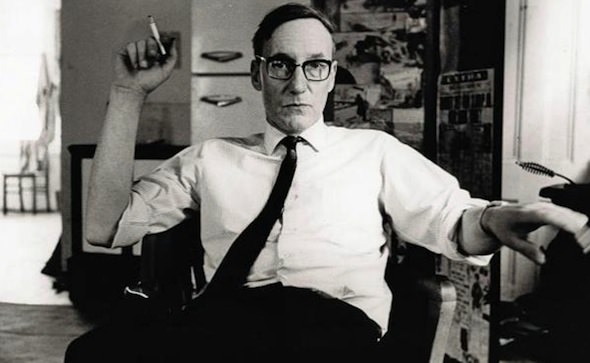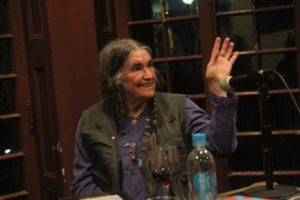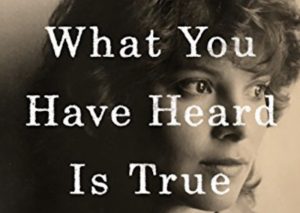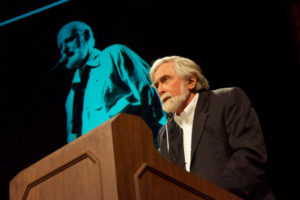|
To see long excerpts from “Call Me Burroughs” at Google Books, click here.
|
“Call Me Burroughs: A Life”
A book by Barry Miles
Years ago I wrote a damning review of Daniel Boorstin’s “The Creators.” Ostensibly a study of the artistic imagination, this huge book was suffused with its author’s disapproval of the people he was writing about. So many of these writers and painters were not the sort of guests one would want at an elegant Georgetown dinner party. They were drug addicts, perverts, drunks, sex fiends, adulterers, panhandlers, nutcases and criminals. They were, in short, creeps. Some were even murderers.
William S. Burroughs (1914-1997) — the subject of Barry Miles’ overwhelming, enthralling biography — was certainly all these things and more. Nonetheless, the author of “Junky” (1953), “Naked Lunch” (1959), “Nova Express” (1964) and many other books even now remains one of the most influential writers of the 20th century. Part of the original Beat trinity with his friends Jack Kerouac and Allen Ginsberg, Burroughs subsequently provided inspiration for New Wave and later science fiction writers (notably J.G. Ballard, Samuel R. Delany and William Gibson), pop artists, punk rockers, libertarians, filmmakers, and cultural and artistic rebels of every stripe.
Some of Burroughs’ charisma arose from his appearance. Despite the outrageousness of his books and life, he dressed like a repressed bank clerk or an especially somber funeral director, almost always appearing in public in a three-piece Brooks Brothers suit and black lace-up dress shoes. He was, after all, a scion of the Burroughs adding machine family, brought up in St. Louis in an upper-class household with servants, educated at Harvard and supported by a monthly allowance from his parents until he was 50.
Miles relates Burroughs’ extraordinary life in an equally extraordinary biography, a mesmerizing page-turner depicting not just a season in hell but an entire lifetime. It is also, to use words seldom associated with its subject, balanced, measured and evenhanded. Miles doesn’t glorify Burroughs, nor does he excuse him for the death of his wife Joan (shot during a William Tell act when they were both drunk), the utter neglect of his pathetic son, William S. Burroughs III, and the sexual exploitation of desperately poor boys in Tangier and elsewhere.
But Miles also recognizes why Burroughs matters. In “Naked Lunch” and his other semi-autobiographical, visionary works, one finds the fascination of the abomination, a willingness to depict anything in lovingly clinical detail — no matter how repugnant or shocking. Yet Burroughs’ fantasticated naturalism doesn’t preclude gallows humor. His “routines” — as he dubbed his books’ various episodes — are half-vaudeville, half-torture garden, while his energetic, jackhammer prose delivers a steady onslaught of striking names and images: the city of Interzone, the Heavy Metal Kid, the Assistant Arbiter of Explanations, the Complete All American Deanxietized Man, the Reality Studio. In this freak-filled, homoerotic world, the zanily macabre Dr. Benway once “performed an appendectomy with a rusty sardine can” and, on another occasion, removed a tumor with his teeth. Here, even “the air is cloyed with a sweet evil substance like decayed honey.”
In Burroughsland paranoia, sadism and the vilest proclivities are utterly normal. Plazas and city streets are overrun by “catatonic youths dressed as women in gowns of burlap and rotten rags,” and by “followers of obsolete unthinkable trades, doodling in Etruscan, addicts of drugs not yet synthesized, black marketeers of World War III, excisors of telepathic sensitivity, osteopaths of the spirit, investigators of infractions denounced by bland paranoid chess players, servers of fragmentary warrants taken down in hebephrenic shorthand charging unspeakable mutilations of the spirit, officials of the unconstituted police states, brokers of exquisite dreams and nostalgias tested on the sensitized cells of junk sickness and bartered for raw materials of the will, drinkers of the Heavy Fluid sealed in translucent amber of dreams.”
Among his near contemporaries, Burroughs most admired Celine, Jean Genet and Samuel Beckett. Like them, he could describe filth and degradation, all the carny grotesqueness of modern urban life, in lyrical and memorable prose. Such maudit writers expose the posturings of polite society, all the supposed verities, and reveal the heart of darkness in each of us. (Joseph Conrad was Burroughs’ favorite author.) Little wonder that these iconoclasts remain perennial favorites with the disaffected young. They can’t be co-opted into any safe literary tradition.
Control was Burroughs own particular obsession, his overarching theme: Addiction controls us, governments control us, our neuroses control us, it’s even possible that insectile aliens from another galaxy control us. Burroughs consequently probes and describes methods of subjugation — drugs, torture, sex, laws, cults, brainwashing and, of course language — so that we may, at the very least, recognize the shackles that bind us. Still, try as one may, there is always “one Mark you cannot beat. The Mark Inside.”
Given its Melvillean echo, “Call Me Burroughs” is, unsurprisingly, a book of travels as much as a biography. Cared for by a nanny who probably involved the little boy in sex games, Burroughs later attended the Los Alamos Ranch School, the most expensive private school in the country, traveled first-class in Europe as a teenager, majored in English at Harvard and eventually managed to live in New York, Chicago, New Orleans, Texas, Mexico City, the South American jungle, London, Tangier, Paris and, finally, Lawrence, Kan., where he spent the last 16 years of his life. Along the way Burroughs would take up but soon drop various jobs, most memorably that of a professional pest exterminator. Drawn to the lowlifes and the criminal classes, he started selling drugs and soon got hooked on heroin and cocaine himself. As the years rolled by, he would undergo rehabilitation and treatment, get clean but eventually relapse. Even as an old man, he was still relying on marijuana to help him through the day.What with his druggy, promiscuous lifestyle, Burroughs was also consistently in minor trouble with the law and a regular visitor to doctors and hospitals. He often carried a gun, sometimes a hidden derringer, and owned several pistols, shotguns and rifles. At times, he sported a swordstick or kept a switchblade and a can of mace in his pockets. In person he could be punctiliously polite and attentive or just remain unnervingly silent. People found him cold, removed. He did not enjoy a happy life.
But he had an ear for prose, no question of that, even if he relied on friends like Ginsberg and the painter Brion Gysin to help assemble his books. With Gysin, Burroughs pioneered the use of “cut-ups” — rearranging strips of type from newspapers and other texts until they made a kind of sense — and thus created through this labor-intensive technique “The Soft Machine” (1961) and “The Ticket That Exploded” (1962). In later years, Burroughs himself took up painting, and his canvases have been exhibited around the world and are the subject of increasing scholarly study.
All these matters and much, much else are carefully elucidated in these cleanly written, gossipy and fact-filled pages. Note, though, that Miles concentrates almost exclusively on his subject’s life, avoiding any detailed consideration of the books themselves. In other words, “Call Me Burroughs” isn’t a critical biography like Richard Ellmann’s “James Joyce.” But in every other respect, it’s a comparably magisterial work, exactingly researched and fascinating throughout.
©2014, Washington Post Book World Service/Washington Post Writers Group










You need to be a supporter to comment.
There are currently no responses to this article.
Be the first to respond.